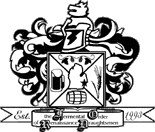
|

|

|

|

|

|
| September 2003 | Fermental Order of Renaissance Draughtsmen | Volume 11 Number 9 |
The next meeting will be held back at Bailey's Pub 'N Grille in Dearborn on Wednesday, September 24. Bailey's is located on the southeast corner of Michigan and Mason. Their address is 22091 Michigan Avenue and their phone number is 313-277-3212. As usual, the thirsty hardcore who want dinner will start arriving around 5PM, people will drift in for an hour or so, and we will start our meeting around 6PM.
August's Lawnmower Beer competition results are shown below
| Lawnmower Beer Competition | |||
|---|---|---|---|
| Place | Brewer | Style | Points |
| 1st | John and Sheila Rucinski |
Cream Ale |
38/50 |
| 2nd | John and Sheila Rucinski |
American Blonde |
37.5/50 |
| 3rd | Bob & Kim Barrett |
Classic American Pilsner |
37/50 |
| HM | John and Sheila Rucinski |
Cream Ale w/lime |
36.5/50 |
| HM | Steve Close |
American Wheat |
34/50 |
| HM | Chris Frey |
APA |
33.0/50 |
This month's competition is Koelsch and Altbier BJCP Category 8. It is another AHA competition The details for the club only competition can be found on the appropriate AHA web page. Bottle and entry forms (useful for non-AHA competitions) can be found there too.
The BJCP description is:8. KOELSCH AND ALTBIER
8A. Koelsch-Style Ale
Aroma: Light hop aroma, German noble or Czech Saaz hops, giving a light fruitiness. Maltiness none to low. No diacetyl, as this is a lagered beer resulting in a clean finish with just a hint of fruitiness from primary fermentation at ale temperatures. Low sulfur aroma, similar to that of pale continental lagers, is acceptable, particularly in a young Koelsch.
Appearance: Very pale to light gold. Very clear/brilliant. White head lingers as Belgian lace on the sides of the glass.
Flavor: Soft, rounded palate; light hop fruitiness and a delicate dryness to slight sweetness in the finish. Clean fermentation with just a little residual fruitiness from ale fermentation temperatures. No diacetyl. Medium-low bitterness. Balanced toward bitterness but malt character should not be completely overshadowed.
Mouthfeel: Light side of medium body. Medium carbonation. Smooth, crisp mouthfeel.
Overall Impression: A delicately balanced beer with just a hint of flavor/aroma hops and fruitiness that finishes dry to slightly sweet with a crisply refreshing bitterness over a base of smooth, rounded Pils malt flavor.
History: As an appellation, the Koelsch name can only be used for beers brewed in Koeln (Cologne), Germany, where it is a native style.
Comments: Brewed at ale temperatures, then cold conditioned to reduce fermentation byproducts.
Ingredients: European hops only. Pils malt; small amounts of wheat may be used (<25%).
Vital Statistics: OG: 1.040-1.048
IBUs: 16-30 FG: 1.008-1.013
SRM: 3.5-5 ABV: 4.0-5.0%
Commercial Examples: Available in Koeln only: Malzmuehle, Hellers, PJFrueh, Paeffgen, Sion, Kueppers. In the US: Hollywood Blonde.
8B. Duesseldorf Altbier
Aroma: Munich malt aroma, with a restrained fruitiness. Hop aroma may vary from low to moderate.
Appearance: Orange-copper to brown color, with brilliant clarity. Thick, persistent head.
Flavor: Assertively bitter, with intense Munich malt-derived flavor to support. Fruity esters should be restrained; some chocolatey notes are often present. Hop flavor should be low to medium.
Mouthfeel: Medium-bodied, with moderate carbonation. Some commercial examples have a dry finish resulting from a combination of high bitterness, higher attenuation, and moderate sulfate in the water.
Overall Impression: Bitterness is very high, especially in relation to the (moderate) gravity. Munich malt character lends balance, resulting in a bittersweet character. Very smooth from fermentation at the lower end of the temperature range for ales, followed by a period of lagering.
History/Comments: A very bitter beer with a pronounced Munich malt character. Ingredients, fermentation at low temperature (for an ale), and a lagering period combine to lend a cleaner palate than for most ales. Predates the isolation of bottom fermenting yeast strains, though it approximates many characteristics of lager beers. Many Northern German Altbiers are lagers.
Ingredients: German Munich malt is essential to obtaining the necessary depth of malt character. Hops are traditionally Spalt, though other German varieties are often used.
Vital Statistics: OG: 1.040-1.055
IBUs: 40-60 FG: 1.012- 1.019
SRM: 11-19 ABV: 5-5.5%
Commercial Examples: Zum Uerige, Zum Schluessel, Im Fuchschen, Widmer Ur-Alt, Schumacher.
8C. Northern German Altbier
Aroma: Little aroma; malt should dominate to the extent that any aroma is discernible.
Appearance: Copper to brown color; very clear. Good head retention.
Flavor: Assertively bitter yet balanced. Munich malt-derived flavor, along with a chocolate-like malt aspect, supports the bitterness. Esters are restrained, and hop flavor should be low to medium.
Mouthfeel: Medium body, with an overall balanced impression.
Overall Impression: A very clean and relatively bitter beer, balanced by Munich malt character. Less intense than the Duesseldorf version of Altbier.
Comments: Most Altbiers produced outside of Duesseldorf are of the Northern German style. Many are simply moderately bitter brown lagers.
Ingredients: Typically made with a Pils base and colored with roasted malt or some dark color syrup. May include Munich malt. Hops are traditionally Spalt, though other German varieties may be substituted.
Vital Statistics: OG: 1.040-1.055
IBUs: 25-40 FG: 1.012-1.019
SRM: 11-19 ABV: 5-5.5%
Commercial Examples: DAB Dark, Diebels Alt, Alaskan Amber, Grolsch Autumn Amber.
Jim Suchy wrote this article for the Michigan Beer Guide, and Bob Barrett rewrote parts of the edition that you see here to highlight the F.O.R.D. Brewers.
BOS
at the Michigan State Fair
Well another Michigan State
Fair Homebrew Competition is behind us and we’ve not only
survived, but thrived! This year we took in 336 homebrewed beer
entries from brewers scattered through Michigan. This was up from
last year’s total of 311 but our 2003 total does not include
two brewers who are usually good for 20 entries a piece. It was a BIG
year! The several drop-off points (Adventures in Homebrewing, Cap ‘N
Cork, and Red Salamander) seemed to help the total a bit and we only
had 4 entries arrive by UPS. The winner’s list this year had
many new faces and there were many first time entrants like last
year. I really do hope this means good things for our hobby.
The
first round judging was held on August 3rd in space donated by Arbor
Brewing Co. in Ann Arbor. The Best of Show (BOS) judging was held on
August 23rd at the State Fairgrounds in Detroit with many of the
winners in attendance. The judges for the (BOS) included such beer
dignitaries as Rex Halfpenny, Larry Bell, Ed Wolfe, Ken Schramm and
Rick Georgette. We finally had Rick on the other side of the table
instead of accepting his many awards. The work was cut out for the
judges who had to wade through 18 first place entries to determine
which beer truly deserved the title “Best of Show”.
This year’s Best of Show Award was given to Bob and Kim
Barrett for their Classic American Pilsner. For those of you who say
the big beers always take best of show, this C.A.P. has something
different to say! For their award they earned a $200 gift certificate
to Pico Brewing Systems and an engraved glass carboy. Bob and Kim
have won numerous awards in this competition and the Over the Mill
competition and are active members of two local homebrew clubs: The
Ann Arbor Brewer’s Guild and the Fraternal Order of Renaissance
Draughtsmen. Way to go!
Other F.O.R.D. members that won awards are:
Tyler Barber – 1st Place European Dark Lager/Bock-Doppelbock
2nd Place European Dark Lager/Bock-Munich Dunkel
1st Place Amber Lager – Oktoberfest
Steve Close – 2nd Place English and Scottish Strong Ale-Wee Heavy
Bob and Kim Barrett – 1st Place American Light Lager/Light Ale-Classic American Pilsner
3rd Place English and Scottish Strong Ale-Old Ale
3rd Place
Barleywine/Imperial Stout-Imperial Stout
The Rex Halfpenny
Award (given to the brewer with the most placing entries) was given
to Phil Kitkowski for his two first place, two second place and one
honorable mention entries. Briess Malting (Chilton, WI) and
Adventures in Homebrewing (Dearborn, MI) provided prizes for this
award.
This year’s competition would not have been
possible without the sponsorship of the following businesses. Make
certain you thank our sponsors with your patronage:
The
Kalamazoo Brewing Co. (Bell's)
Arbor Brewing Co.
pico Brewing
Systems
Arcadia Brewing Co.
Adventures in Homebrewing
White
Labs Yeast Co.
Hopunion
Briess Malting
The Homebrew
Digest
The Winner's Circle Booklet with all of the first place
recipes is being assembled now and will be available around town. The
recipes should be available in electronic format off the MSF Homebrew
Comp website (hbd.org/michigan) soon.
I am looking for some
volunteers for next year's competition. If you are interested in
helping out, contact me (msfhomebrew@hotmail.com or 734-722-9238).
Here's The Winners:
American Lager/Light Ale
1’st
Bob & Kim Barrett, Classic American Pilsner(AABG & FORD)
2nd
Phil Kitkowski, Blond Ale
3rd Tate Bushy, American Lager Gratiot
County
European Pale Lagers
1st Kirk Rowland, Muenchner
Helles
2nd Jeff Rankert, Northern German Pilsner (AABG)
3rd
David Coleman, Muenchner Helles
Bitter & English Pale
Ale
1st Randy Panduren, Ordinary Bitter
2nd Adam Bigham, Strong
Bitter
3rd George Borysko, Strong Bitter
IPA
1st Phil
Kitkowski. India Pale Ale
2nd Fred Goeldi Jr.. India Pale Ale
3rd
Richard Gretz, India Pale Ale (Primetime Brewers)
Scottish
Ale/Brown Ale/Mild
1st Kurt Klimkiewicz. Export 80
2nd Richard
Scott, Export 80 (Downriver Brewers Guild)
3rd Fred Goeldi Jr.,
Northern English Brown
Pale Ale/California Common
1st John
Applegarth, American Pale Ale (Primetime Brewers)
2nd R. Jeff
Ricker, California Common (Prison City Brewers)
3rd Denis Fleming,
American Pale Ale, (No Restraints)
American Amber Ale/Wheat
Beer
1st Randy Panduren, Dunkelweizen
2nd Fred Rouse, Bavarian
Weizen
3rd Dan Humphrey, Dunkelweizen (Prime Time Brewers)
German
Ale
1st Phil Kitkowski, Koelsch
2nd Brad Sancho, Northern
German Altbier
3rd Craig Wolfangel, Northern German Altbier
(AABG)
European Dark Lager/Bock
1st Tyler Barber,
Doppelbock (FORD)
2nd Tyler Barber, Munich Dunkel (FORD)
Amber
Lager
1st Tyler Barber, Oktoberfest (FORD)
2nd Dave Novak,
Vienna Lager (Red Ledge Brewers)
3rd Fred Rouse,
Oktoberfest
English and Scottish Strong Ale
1st Dan
Humphrey, Old Ale (Primetime Brewers)
2nd Steve CloseWee Heavy
(FORD)
3rd Bob & Kim Barrett, Old Ale (AABG &
FORD)
Barelywine/Imperial Stout
1st Jeff Carlson, American
Barleywine (Primetime Brewers)
2nd Phil Kitkowski, American
Barleywine
3rd Bob & Kim Barrett, Imperial Stout (AABG &
FORD)
Porter
1st John Schwab, Brown Porter (KLOB)
2nd
William Bailey, Robust Porter
3rd Bob Krueger, Brown Porter
(CRAFT)
Stout
1st Richard Scott. Dry Stout (Downriver
Brewers)
2nd Jon Taisey. Oatmeal Stout (Sheep Fanciers Homebrew
Club)
3rd Dave Mitsch. Oatmeal Stout (Downriver Brewers)
Belgian
and French Ale/Lambic
1st Tom Hughes, Raspberry Lambic
2nd
Craig Wolfangel, Witbier (AABG)
3rd Eric and Kurt Bachmann,
Belgian Specialty Ale (CRAFT)
Strong Belgian Ale
1st Kirk
Rowland, Dubbel
2nd Denis Fleming, Strong Dark Ale (No
Restraints)
3rd Lawrence Rapson, Tripel (Cass River
Brewers)
Fruit Beer
1st Mark Ohrstrom, Tart Cherry Vienna
(AABG)
2nd Dan Humphrey, Raspberry Wheat (Primetime Brewers)
3rd
Erik Wetzler, Raspberry Ale
Spice/Herb/Vegetable/Smoke
Beer
1st Phil Wilcox, Rauchbier (Prison City/AABG)
2nd Fred
Goeldi Jr, .Spiced Amber
3rd Jeff Carlson, Smoked Mild (Primetime
Brewers)
Chris Frey
Well, we whiled away another summer and believe it or nor, the cold brewing weather is right around the corner. And along with the summer heat is gently being ripped through our skies by Hurricane Isabelle, thoughts of a club function waft through the air. It seemed that everyone was a little busier, time a little more elusive as we attempted to find agreeable times and locations for a beer-b-que this year, and in the end it seemed the best thing to do was not put one more thing into people's already busy summers.
So we're going to be the first to fill up on your hectic holiday season! That's right, an early holiday gathering is in the making. Initially we have chosen Saturday evening, December 6th for this event. Both Kathy Loftus and Jim Rice have done some research on the availability and we have tentatively secured two locations. Both will be discussed at next Wednesday's meeting at Bailey's and a vote from the masses will be in order. Please plan to attend and VOICE YOU CHOICE!

There will be of Chrispy's AHA pictures next month.
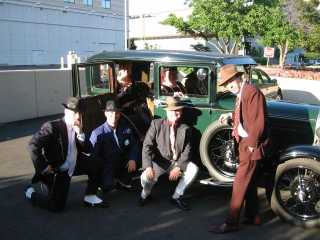 |
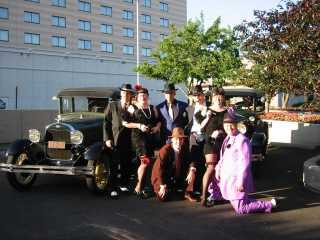 |
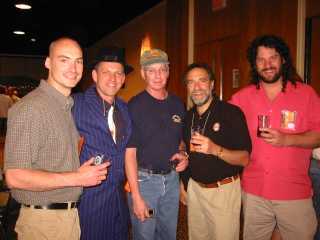 |
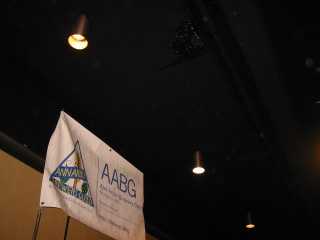 |
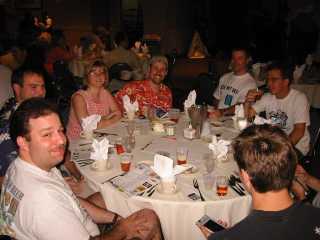 |
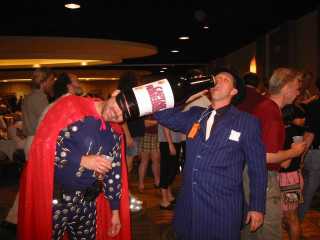 |
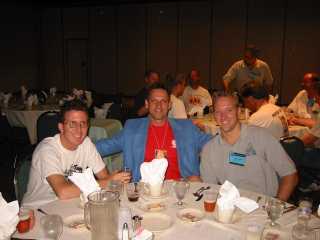 |
 |
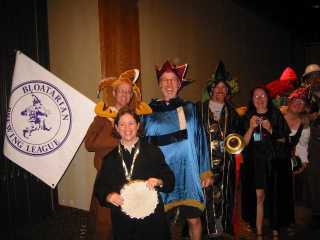 |
 |
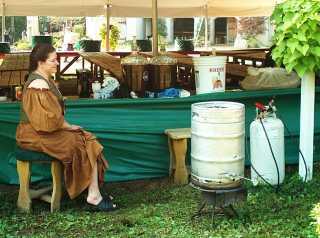 |
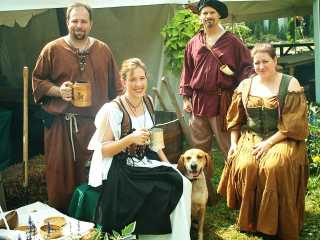 |
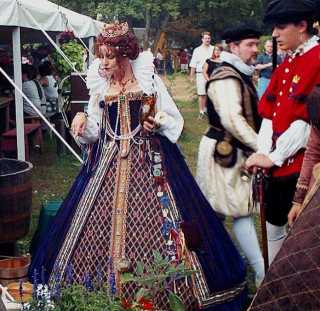 |
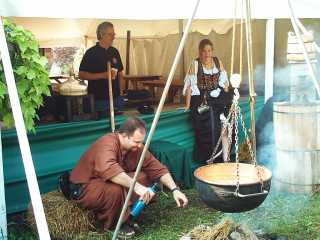 |
Next month's competition is Wheat BJCP Categories 3B, 17, 19B & Belgian Styles BJCP Categories 18, 19, & 20
3B. American Wheat
Aroma: Characteristic of wheat with some graininess. Bavarian Weizen's clovey and banana aromas are inappropriate. Hop aroma may be high or low but if present will be from American hop varieties.
Appearance: Usually pale straw to gold. Dark versions approximating Dunkel Weizens are acceptable. Clarity may range from brilliant to hazy with yeast approximating the hefe Weizen style of beer. Big, long-lasting head.
Flavor: Light graininess. Bavarian Weizenbier flavors such are banana esters and clove-like phenols are inappropriate. Hop flavor may be from low to high. Hop bitterness low to medium. Some fruitiness from ale fermentation acceptable; however, the use of a fairly neutral American ale yeast usually results in a clean fermentation. Little to no diacetyl.
Mouthfeel: Light to medium body. Higher carbonation is appropriate. Mouthfeel will appear lighter than actual body due to higher levels of carbonation.
Overall Impression: A light, refreshing beer that exhibits balanced hop and wheat maltiness.
Ingredients: Standard ale yeast. Often 50% wheat malt or more.
Vital Statistics: OG: 1.035-1.055
IBUs: 10-30 FG: 1.008-1.015
SRM: 2-8 ABV: 3.7-5.5%
Commercial Examples: Otter Creek Summer Wheat, Anchor Wheat, Boulevard Wheat, Pyramid Hefe-Weizen.
17. WHEAT BEER
17A. Bavarian Weizen
Aroma: Vanilla and clove-like phenols and fruity esters of banana are common. Hop aroma ranges from low to none. No diacetyl. Some aroma of wheat may be present.
Appearance: Pale straw to dark reddish-gold in color. A very thick, long-lasting head is characteristic. High protein content of wheat may impair clarity in an unfiltered beer, and clarity can be deliberately cloudy in a Hefe-Weizen from suspended yeast sediment. The filtered Krystal version is quite clear.
Flavor: The soft, grainy flavor of wheat is essential. Hop flavor is low to none and hop bitterness is very low. A tart character from yeast and high carbonation may be present. Spicy clove phenols and fruity esters, most prominently banana, are often present. No diacetyl.
Mouthfeel: The texture of wheat imparts the sensation of a fluffy, creamy fullness that may progress to a surprisingly light finish. A high carbonation level is typical.
Overall Impression: A pale, spicy, fruity, wheat-based ale.
History: A traditional wheat-based ale from Southern Germany that is a specialty for summer consumption.
Comments: These are refreshing, fast-maturing beers that are lightly hopped. The Hefe-Weizen version is served with yeast sediment stirred into it. The Krystal version is filtered for excellent clarity.
Ingredients: A high percentage of malted wheat is used which typically constitutes 50% or more of the grist, the remainder being pale barley malt. Weizen ale yeast produces the typical spicy and fruity essences during a relatively warm fermentation. Hops are used for a small amount of bittering only. Water character will vary.
Vital Statistics: OG: 1.040-1.056
IBUs: 10-20 FG: 1.010-1.014
SRM: 2-9 ABV: 4.3-5.6%
Commercial Examples: Paulaner Hefe-Weizen, Pschorr-Brau Weisse, Spaten Club-Weisse, Schneider Weisse, Julius Echter Weizenbier.
17B. Bavarian Dunkelweizen
Aroma: Gentle aroma of Munich malt supported by fruity, notably banana, and clove-spice aromas. No hop aroma. No diacetyl.
Appearance: Light amber to light brown in color. A thick, long-lasting head is characteristic. High protein content of wheat may impair clarity in an unfiltered beer.
Flavor: Melanoidins and caramel character of Munich and Vienna-type malts is prominent, along with some wheat flavor. There may be some spicy, fruity flavor as well. Roasty character is rare and very restrained if present. Low hop bitterness. No hop flavor. No diacetyl.
Mouthfeel: The texture of wheat imparts the sensation of a fluffy, creamy fullness that may progress to a lighter finish. However, the presence of Munich and Vienna-type malts provides its own sense of fullness. A moderate to high carbonation level is typical.
Overall Impression: A dark, malty, spicy, wheat-based ale.
History: A dark version of Bavarian Weizen.
Comments: The presence of Munich and Vienna-type barley malts gives this style a deeper and richer barley malt character than Bavarian Weizen. Often, there is less of the tart quality as well.
Ingredients: Wheat malt typically makes up 50% or more of the grist, the remainder being Munich or Vienna-type high-kilned barley malts. Some dark wheat malts may be used. Dark roasted malts are rarely used and then only in very small concentrations. Hops provide a mild bitterness only. Weizen ale yeast is used. Water character will vary.
Vital Statistics: OG: 1.040-1.056
IBUs: 10-20 FG: 1.010-1.014
SRM: 10-23 ABV: 4.3-5.6%
Commercial Examples: Pschorr-Brau Dunkel Weiss, Franziskaner Dunkel-Weizen, Schneider Dunkel Weiss.
17C. Berliner Weisse
Aroma: Slightly fruity; a sour aspect may be quite noticeable. On occasion a mild Brettanomyces yeast aroma may be present. No hop aroma. No diacetyl.
Appearance: Very pale straw in color. Clarity ranges from fair to cloudy. Despite high carbonation, head retention can vary from moussy to low.
Flavor: Lactic sourness dominates and can be quite strong, but some wheat flavor should be noticeable. Hop bitterness is very low. Mild Brettanomyces yeast character may be detected occasionally. No hop flavor. No diacetyl.
Mouthfeel: Light body. High carbonation.
Overall Impression: A very pale, sour, refreshing, low-alcohol wheat ale.
History: A regional specialty of Berlin; referred to by Napoleon's troops in 1809 as "the Champagne of the North" due to its lively and elegant character.
Comments: Often served with the addition of sugar syrups flavored with raspberry or woodruff to counter the substantial sourness. Has been described by some as the most purely refreshing beer in the world.
Ingredients: Wheat malt content is typically well under 50% of the grist, the remainder being pale barley malt. Lactobacillus delbruckii culture and fermentation provides the sharp sourness, which may be enhanced by blending of beers of different ages during fermentation and by extended cool aging. Ale yeast ferments to a low alcohol level. Hop bitterness is extremely low. Water may have significant hardness.
Vital Statistics: OG: 1.026-1.036
IBUs: 3-8 FG: 1.006-1.009
SRM: 2-4 ABV: 2.8-3.6%
Commercial Examples: Schultheiss Berliner Weisse, Berliner Kindl Weisse.
17D. Weizenbock
Aroma: A powerful aroma of ripe fruit is very common. Aroma of alcohol is also common. Some clove-spice aroma may be present. No hop aroma. No diacetyl.
Appearance: Light amber to dark brown in color. High alcohol level may impair what would otherwise be a thick, long-lasting head. Wheat protein content may impair clarity.
Flavor: Concentrated wheat flavor is dominant. Malty complexity, including smoky or raisin-like essences, may be present in darker versions. A fruity character is common, and some clove-spice flavor may occur. Well-aged examples may show some sherry-like oxidation as a point of complexity. Hop bitterness is well controlled to allow wheat and malt flavors to dominate the balance. No hop flavor. No diacetyl.
Mouthfeel: Full-bodied. A creamy sensation is typical, as is the warming sensation of substantial alcohol content. Moderate carbonation.
Overall Impression: A strong, malty, fruity, wheat-based ale.
History: A Bavarian specialty first introduced by Schneider in 1907 under the Aventinus name.
Comments: A Bock among Bavarian Weizen beers.
Ingredients: Wheat malt is typically 50% or more of the grist, the remainder barley malts. Hops provide mild bitterness only. Weizen ale yeasts are used. Water character can vary.
Vital Statistics: OG: 1.066-1.080+
IBUs: 15-30 FG: 1.015-1.022
SRM: 7-25 ABV: 6.5-8.0%+
Commercial Examples: Schneider Aventinus, Erdinger Pikantus, Pyramid Weizenbock.
18. STRONG BELGIAN ALE
18A. Dubbel
Aroma: Rich malt aromas are typical; many dubbels have raisiny and other fruity ester aromas. No roasted malt aroma. Some higher alcohol aromas (peppery, spicy) are common. Mild to moderate clove-spice aromas may be present. Hop aroma is faint to none. No diacetyl.
Appearance: Dark amber-brown in color. Clarity is usually fair to good. Head retention may be adversely affected by alcohol content in stronger versions.
Flavor: Rich malty and fruity flavors bring the balance toward malt throughout. Some commercial examples are malty, yet dry; raisin flavors are common. A slight to moderate clove spiciness may be present. Hop flavor is low to none. No diacetyl.
Mouthfeel: Medium-full to full body. Warming mouthfeel from alcohol.
Overall Impression: A dark, rich, malty, moderately strong ale.
History: Originated at monasteries in the Middle Ages, and was revived in the mid-1800s after the Napoleonic era.
Comments: By Belgian law, to be called a Trappist Ale, it must be brewed at a Trappist monastery. Home brewed and secular equivalents should be called abbey ales.
Ingredients: Yeast strains prone to production of higher alcohols, esters, and clove-spice aroma and flavor are most commonly used. Dark(caramelized) candi sugar is a common and significant addition for color and flavor contributions.
Vital Statistics: OG: 1.040-1.080
IBUs: 20-35 FG: 1.012-1.018
SRM: 10-20 ABV: 3.2-7.8%
Commercial Examples: Westmalle Dubbel, LaTrappe Dubbel, Affligem Dubbel, Steenbrugge Dubbel, Celis Dubbel, Westvletteren 4.
18B. Tripel
Aroma: Complex aroma of malt and fruity esters, which may have a “citrus-like” essence, and often a mild to moderate clove-spice character. Hop aroma may be moderate to none. No diacetyl.
Appearance: Pale gold to deep gold in color. Clarity should be fair to good. Head retention may be quite good, or may be adversely affected by alcohol content in some versions.
Flavor: Crisp and moderately fruity. Malty sweetness is balanced by restrained hop bitterness and high carbonation to provide a dry finish to the palate and a sweet aftertaste. Clove-like spiciness is apparent in many examples. The best examples have subtle alcohol undertones, while others may have very noticeable alcohol presence. Hop flavor may be moderate to none. No diacetyl.
Mouthfeel: Medium body, although a light impression (thanks to the candi sugar) given the often substantial original gravity. High alcohol content adds a warming sensation. Carbonation is very high and effervescent in character, yet ideally does not disturb the beer's smoothness.
Overall Impression: A pale, moderately fruity, spicy, very strong ale.
History: Originally developed at the Trappist monastery at Westmalle.
Comments: Alcoholic, but the best examples do not taste strongly of alcohol. By Belgian law, to be called a Trappist ale it must be brewed at a Trappist monastery. Home-brewed and secular equivalents should be called abbey ales.
Ingredients: Yeast strains prone to higher alcohol and clovey aroma production are usually used. Small amounts of spices are sometimes added. Pale Pilsner malts are used and up to 25% white candi sugar (sucrose) is often added.
Vital Statistics: OG: 1.065-1.095
IBUs: 20-35 FG: 1.013-1.020
SRM: 3.5-6 ABV: 6.3-10%
Commercial Examples: Westmalle Tripel, Affligem Tripel, Grimbergen Tripel, Corsendonk Monk's Pale Ale, Bruggse Tripel, New Belgium Trippel[sic].
18C. Belgian Strong Golden Ale
Aroma: Fruity esters are common, and the malt character is light. Some clove-spice character may be present, from either warm fermentation or actual spice additions. A spicy hop aroma is sometimes found. No diacetyl.
Appearance: Pale yellow to golden in color. Good clarity. Long-lasting foam stand resulting in characteristic Belgian lace on the glass.
Flavor: Full of fruity, hoppy, alcoholic complexity, supported by a soft malt character. A slight presence of spices, from either warm ferment or actual spice additions, may be present as a point of complexity. Hop bitterness is typically restrained. Substantial carbonation may lend a dry flavor to the palate despite a sweet aftertaste. No diacetyl.
Mouthfeel: Medium body gives a light impression despite the often substantial original gravity and alcohol content. Usually effervescent, yet with a smooth finish.
Overall Impression: A very pale, effervescent, complex, strong ale.
History: Most versions reflect the unique products of individual breweries.
Comments: References to the devil are included in the names of many commercial examples of this style. The best examples are elegant, complex, and balanced.
Ingredients: The light color and relatively light body for a beer of this strength are the result of using very pale malt and up to 20% white candi sugar (sucrose). Some versions include the use of spices for subtle complexity.
Vital Statistics: OG: 1.065-1.080
IBUs: 25-35 FG: 1.014-1.020
SRM: 3.5-5.5 ABV: 7-9%
Commercial Examples: Duvel, Lucifer, La Chouffe, Moinette, Celis Grand Cru.
18D. Belgian Strong Dark Ale
Aroma: The intermingling aromas of Munich-type malt, alcohol and fruity esters are typical, along with spicy phenols which may be contributed by warm yeast fermentation and/or actual spice additions. Hop aroma may vary from moderate to none. Typically there is no strong dark(roast) malt aroma. No diacetyl.
Appearance: Deep burgundy to dark brown in color. Clarity may be fair to good. Head retention may be quite good or may be adversely affected by high alcohol content.
Flavor: Ripe fruit flavors, including raisin and plum, are common. Malt usually dominates, but some examples are balanced slightly toward bitterness. Some spicy phenols, from ferment or actual spices, may be present. Hop flavor can range from moderate to none. Some sweetness is contributed by alcohol. No diacetyl.
Mouthfeel: Medium to full body, creamy and warming.
Overall Impression: A dark, very rich, complex, very strong ale.
History: Most versions are unique in character reflecting the characteristics of individual breweries.
Comments: Some beers of this type are brewed at or in association with monasteries, and some are not. In comparison to Dubbel, these are typically significantly stronger beers of a wider variety.
Ingredients: Dark candi sugar is a frequently-used additive and may contribute as much or more color and flavor as dark Munich or caramel malts. Spices are sometimes added for complexity. Yeasts prone to production of higher alcohols, esters and spicy phenols are commonly employed.
Vital Statistics: OG: 1.065-1.098+
IBUs: 25-40+ FG: 1.014-1.024+
SRM: 7-20 ABV: 7-12+%
Commercial Examples: Pawel Kwak, Gouden Carolus, Scaldis (a.k.a. Bush), Rochefort 10, Chimay Grand Reserve.
19. BELGIAN AND FRENCH ALE
19A. Belgian Pale Ale
Aroma: Prominent but soft-edged aroma of malt, accented by small amounts of phenols, higher alcohols in some versions, and spices in some versions. Hop aroma low to none. No diacetyl.
Appearance: Golden to copper in color. Clarity is fair to good. Good head retention.
Flavor: Fruity and lightly to moderately spicy, with a soft and smooth malt character. Higher alcohols may contribute complexity in some examples, but not harshness. Hop flavor is relatively low. Hop bitterness is moderate, though some examples with high bitterness exist.
Mouthfeel: Light to medium in body, with a smooth quality and moderate carbonation.
Overall Impression: A fruity, slightly spicy, smooth, copper-colored ale.
History: Although produced by breweries with roots as far back as the mid-1700s, most well-known products were perfected after the Second World War with some influence from Britain including yeast strains.
Comments: Best known as a draught beer, and most often encountered in the Belgian province of Antwerp.
Ingredients: Candi sugar may be used as an additive. Yeasts prone to production of higher alcohols and spiciness may or may not be used. On occasion spices are used for subtle uniqueness.
Vital Statistics: OG: 1.040-1.055
IBUs: 20-35 FG: 1.008-1.013
SRM: 3-14 ABV: 3.9-5.6%
Commercial Examples: Celis Pale Bock, De Koninck, Special Palm Ale, Ginder Ale.
19B. Witbier
Aroma: A sweet and occasionally honey-like character with prominent citrus (notably orange), herbal and spice aromas is characteristic, and is often followed by a mild phenolic aroma. Hop aroma is low to none. No diacetyl.
Appearance: Very pale straw to very light gold in color, and generally cloudy. Head retention should be quite good and of a moussy character.
Flavor: The flavor of unmalted wheat is typically noticeable. Coriander, citrus and mild phenolic flavors contribute to a complex and elegant character. A very slight lactic acidity resulting from a limited Lactobacillus fermentation is present in some examples, providing a refreshing quality, and is absent in others. Hop flavor is low to none. Hop bitterness is typically restrained, and some bitterness may also be contributed by bitter orange peel. No diacetyl.
Mouthfeel: Light to medium body. Effervescent character of high carbonation. Refreshing acidity.
Overall Impression: A refreshing, elegant, complex, wheat-based ale.
History: A 400-year-old beer style that died out in the 1950s, it was revived by Pierre Celis in the 1960s to steadily growing popularity thereafter.
Comments: The presence and degree of spicing and lactic sourness vary from one brand or brewery to another.
Ingredients: About 50% unmalted hard red winter wheat and 50% pale barley malt constitute the grist; in some versions a small percentage of raw oats is used as well. Spices of freshly-ground coriander and dried orange peel complement the sweet aroma and are quite characteristic; other spices may be used for complexity but are much less prominent. Ale yeast prone to production of mild, clovey/spicey flavors are very characteristic. In some instances a very limited Lactobacillus fermentation, or actual addition of lactic acid, is done.
Vital Statistics: OG: 1.042-1.055
IBUs: 15-22 FG: 1.008-1.012
SRM: 2-4 ABV: 4.2-5.5%
Commercial Examples: Celis White, Hoegaarden Wit, Steendonk Witbier, Brugs Tarwebier, Blanche de Bruges.
19C. Biere de Garde
Aroma: Malt is prominent in the aroma, which is otherwise complex with a slight level of fruity esters, little or no hop aroma, and often a musty/woody character. Higher alcohols may be detected. Diacetyl low to none.
Appearance: Color can vary from full gold, to copper-colored (most common), to a dark reddish-brown. Clarity and head retention are generally good.
Flavor: A medium to high malt flavor often characterized by toffee or caramel aspects is typical. A slight musty or woody character may be present. Hop bitterness is often modest, though subtle and restrained hop flavors may occur. Diacetyl low to none.
Mouthfeel: Medium body, which in the best examples has a very smooth, silky character to it. Alcohol level is medium to strong and gives a warming sensation. Moderate carbonation.
Overall Impression: A rich, complex, malty, moderately strong ale.
History: A farmhouse style from northeastern France which reflects the "March beer" tradition of a stronger beer brewed at the end of the cool season to last through the warm months. Its revival began in the 1970's after nearly disappearing in the aftermath of World War II.
Comments: The name means "beer for keeping," denoting a beer that is strong enough to be stored for quite a while.
Ingredients: Typically made from pale malts and a Vienna or Munich type. Crystal malt plays a prominent role in some examples. A variety of continental hops displaying very subtle floral or spicy aromas and flavors may be used. Some examples are now brewed with lager yeast fermented at higher temperatures. Water is generally soft and imparts a smooth flavor profile.
Vital Statistics: OG: 1.060-1.080
IBUs: 20-35 FG: 1.014-1.022
SRM: 5-18 ABV: 4.5-8%
Commercial Examples: Jenlain, Castelain, Trois Mont, Septante Cinq, Brasseurs Biere de Garde.
19D. Saison
Aroma: Fruity esters dominate the aroma. Complexity is often contributed by hop aroma, complex higher alcohols, herbs and spices, and phenols. Generally the malt aroma is low. No diacetyl.
Appearance: Distinctive pale orange color with a dense, rocky head. Clarity is generally good.
Flavor: Bitter but not assertively so, providing a refreshing character. The hoppy, fruity flavors typical of this style may include citric notes, and often the addition of several spices and herbs. Hop bitterness is moderate, and hop flavor may be moderate to high but should not overwhelm fruity esters, spices, and malt. Malt character is light but provides sufficient structure for the other complex flavors which may include a quenching tartness. No diacetyl.
Mouthfeel: Light to medium body. Very high carbonation with an effervescent quality. Alcohol level can be medium to high.
Overall Impression: A fruity, hoppy, highly carbonated, moderately strong, refreshing ale.
History: The style has origins in the traditions of the "March beer" brewed at the end of the cool season to last through the warmer months. It is now brewed year-round.
Comments: A seasonal summer style produced in Wallonia, the French-speaking part of Belgium.
Ingredients: Pale malt dominates the grist, and a very small fraction of Vienna or Munich malt contributes a touch of color. Hop bitterness and flavor may be more noticeable than in many other Belgian styles, and Saison is often dry-hopped. A number of different spices and herbs may be used to add complexity, interest, and uniqueness to each brewery's products.
Vital Statistics: OG: 1.055-1.080
IBUs: 20-45 FG: 1.010-1.015
SRM: 6-12 ABV: 4.5-8.1%
Commercial Examples: Saison Dupont, Moinette, Laforet, Saison Silly, Sezoens.
19E. Belgian Specialty Ale
Aroma: Most exhibit varying amounts of fruity esters, spicy phenols, and other yeast-borne aromatics; some may include very slight aromas of Brettanomyces and other microflora. Hop aroma may be low to moderate. Malt aroma may be low to high and may include essences of grains other than barley, such as wheat or rye. No diacetyl.
Appearance: Color varies considerably, from pale gold to medium amber. Clarity may be poor to good. Head retention is usually good.
Flavor: A great variety of flavor is found in these beers. Maltiness may be light to quite rich, hop flavor and bitterness generally increase along with the depth of malt quality, and spicy flavors may be imparted by yeast and/or actual spice additions.
Mouthfeel: Most are well-attenuated, thus fairly light-bodied (for their original gravity), and well-carbonated. A warming sensation from alcohol may be present in stronger examples.
Overall Impression: This category encompasses a wide variety of Belgian-style ales that typify the imaginative products often necessary to attract customers in the world's most competitive beer market, Belgium.
History: Unique beers of small independent Belgian breweries that have come to enjoy local popularity, but may be far less well-known outside of their own regions.
Comments: A category for the myriad unusual and distinctive Belgian ales which don't fit into any of the other style descriptions for Belgian-style beers contained in these guidelines. These beers run the gamut of aromas, flavors, colors, mouthfeel and alcohol content and are often fermented with unusual and distinctive yeasts and ingredients. Brewer should specify commercial equivalent for entry, if appropriate.
Ingredients: May include candi sugar additions, unusual grains and malts, and spices or herbs.
Vital Statistics: OG: 1.040-1.070
IBUs: 20-40 FG: 1.008-1.016
SRM: 3-8 ABV: 4-8.0%
Commercial Examples: Orval, Kasteel Bier, DeDolle's Oerbier, Arabier, Stille Nacht, Bokrijks Kruikenbier.
20. LAMBIC AND BELGIAN SOUR ALE
20A. Straight (Unblended) Lambic-Style Ale
Aroma: The aroma of these beers is a complex blend from a wide variety of microbiota, often described in the following terms: horsey, horse blanket, sweaty, oaky, hay, and sour. Other aromas that are found in small quantities are: enteric, vinegary and barnyard. Lambics can also be very fruity, and a corky or woody character may also be detected on occasion. Typically, no hop aroma or diacetyl are perceived.
Appearance: May be cloudy. Head retention is not expected to be very good. Yellow to gold color.
Flavor: Young examples are intensely sour from lactic acid and at times some acetic acid. When aged, the sourness is more in balance with the malt and wheat character. Fruit flavors are simpler in young lambics and more complex in the older examples. Some oak or wood flavor is sometimes noticeable. Hop bitterness is low to none. Hop flavor is absent. Typically, no diacetyl is perceived.
Mouthfeel: Medium to light in body. Bottled lambic ales vary from well-carbonated to not carbonated, and draft lambic is virtually flat.
Overall Impression: Complex, sour, pale, wheat-based ales fermented with a variety of microflora.
History: Uniquely sour ales from the Senne (Zenne) Valley of Belgium which stem from a farmhouse brewing tradition several centuries old.
Comments: Straight lambics have a fruity complexity and intense acidity, and very few are bottled. Blended, aged and bottle-conditioned lambics, called gueuze or geuze, tend to have a smoother palate. Lambic is spelled "lambiek" in Flemish.
Ingredients: Unmalted wheat (30-40%) and aged hops are used. Traditionally, these beers are spontaneously fermented with naturally occurring yeast and bacteria in oak or in some cases chestnut barrels. Home-brewed and craft-brewed versions are more typically made with pure cultures of yeast, including Saccharomyces and Brettanomyces, along with Pediococcus and Lactobacillus bacteria, in an attempt to recreate the effects of the dominant microflora of the Senne/Zenne valley.
Vital Statistics: OG: 1.044-1.056
IBUs: 10-15 FG: 1.006-1.012
SRM: 4-15 ABV: 4.7-5.8%
Commercial Examples: Very few straight (unblended) lambics are bottled. Most commonly available is Grand Cru Cantillon Bruocsella 1900. In the area around Brussels (Bruxelles), there are specialty cafes that have draught lambics from traditional brewers such as Boon, Cantillon, De Neve, Girardin, Hanssens, Vander Linden and Timmermans.
20B. Gueuze/Geuze-Style Ale
Aroma: The aroma of these beers is a complex blend of aromas from a wide variety of microbiota. These aromas include: horsey, horse blanket, sweaty, oaky, hay, and sour. Other aromas that may be found in small quantities are: enteric, vinegary, and barnyard. There can be a very fruity aroma, and some mustiness may be detected. Typically, no hop aroma or diacetyl are perceived.
Appearance: Gold to medium amber color. May be slightly cloudy. Head retention is not expected to be very good.
Flavor: Young examples are intensely sour from lactic acid and at times some acetic acid; when aged, the sourness is more in balance with the malt and wheat character. Fruit flavors from esters are simpler in young Gueuze and more complex in the older examples. A slight oak, cork or wood flavor is sometimes noticeable. Typically, no hop flavor or diacetyl are perceived.
Mouthfeel: Younger bottles (less than five years old) tend to be sparkling, but older vintages are at times less carbonated. Light to medium-light body. Avery faint astringency is often present, like wine, but no more than a well-aged red wine.
Overall Impression: Intensely refreshing, fruity, complex, sour, pale wheat-based ales fermented with a variety of microflora.
History: Uniquely sour ales from the Senne (Zenne) Valley of Belgium which stem from a farmhouse brewing tradition several centuries old. Gueuze is the French spelling, while geuze is the Flemish spelling.
Comments: Gueuze/geuze is traditionally made by blending lambic that ranges in age from three years to less than one year and then bottled. Typically, gueuze/geuze has a smoother palate than straight lambic.
Ingredients: Unmalted wheat (30-40%) and aged hops are used. Traditionally, these beers are spontaneously fermented and aged with naturally occurring yeast and bacteria in oak or chestnut barrels. Home-brewed and craft-brewed versions are more typically made with pure cultures of yeast, including Saccharomyces and Brettanomyces, along with Pediococcus and Lactobacillus bacteria, in an attempt to recreate the effects of dominant microflora of the Senne/Zenne valley.
Vital Statistics: OG: 1.044-1.056
IBUs: 10-15 FG: 1.006-1.012
SRM: 4-15 ABV: 4.7-5.8%
Commercial Examples: Boon, Cantillon, Hanssens, Lindeman's, Boon Mariage Parfait, Girardin, Vandervelden Oud Beersel, DeKeersmaeker.
20C. Fruit Lambic-Style Ale
Aroma: In younger vintages, the fruit with which the beer has been flavored should be the dominant aroma. In old bottles, the fruit aroma typically has faded and other aromas are more noticeable: horsey, horse blanket, sweaty, oaky, hay and sour. Other aromas that maybe found in small quantities are: enteric, vinegary and barnyard. Lambics can be very fruity from esters as well. Typically, no hop aroma or diacetyl are perceived.
Appearance: May be slightly cloudy. Head retention is not expected to be very good. The variety of fruit determines the color.
Flavor: Young examples are intensely sour from lactic acid and at times some acetic acid; when aged, the sourness is more in balance with the fruit, malt and wheat character. Fruit flavors are simpler and more one-dimensional in young lambics (the fruit added being dominant) and more complex in the older examples. A slight oak, cork or wood flavor is sometimes noticeable. Typically, no hop flavor or diacetyl are perceived.
Mouthfeel: Younger bottles (less than five years) tend to be sparkling, older vintages are sometimes less carbonated. Light to medium-light body. A very faint astringency is acceptable, like wine, but no more than a well-aged red wine.
Overall Impression: Intensely refreshing, fruit-flavored, complex, sour, pale, wheat-based ales fermented with a variety of microflora.
History: Uniquely sour ales from the Senne (Zenne) Valley of Belgium which stem from a farmhouse brewing tradition several centuries old. The addition of fruit for flavoring may be a relatively recent post-World War II innovation, however.
Comments: Commonly made by blending two- or three-year-old straight lambic with young (less than 1-year-old) straight lambic, after which fruit is added for further fermentation and aging before bottle-conditioning with very young straight lambic.
Ingredients: A blend of older and younger straight lambics is used as a base. Fruits commonly used for flavoring are cherries (Kriek) and raspberries (Framboise), although more recent commercial examples include peaches (Peche), grapes (Vigneronne or Muscat) and black currants (Cassis). Entrant must specify the type of fruit used in making the entry.
Vital Statistics: OG: 1.044-1.056 (plus the fruit)
IBUs: 10-15 FG: 1.006-1.012
SRM: 4-15 ABV: 4.7-5.8%
Commercial Examples: Cantillon Rose de Gambrinus, Cantillon Kriek, Cantillon Gueuze Vigneronne, Drie Fontainen Kriek, Hanssens Kriek; Boon Kriek Mariage Parfait, Framboise Marriage Parfait.
20D. Oud Bruin
Aroma: Deep complexity of fruity esters and Munich-type malt, including notes of raisins and sherry wine in well-aged examples. A slight sour aroma may be present. Hop aroma is very low to none. Diacetyl is typically medium-low to none.
Appearance: Dark reddish-brown to brown color. Good clarity. Average to good head retention.
Flavor: Malty, with fruity complexity and some caramelization character. A slight sourness may become more pronounced in well-aged examples, along with some sherry-like character, producing a "sweet-and-sour" profile. Hop flavor is low to none. Hop bitterness is restrained. Diacetyl is medium-low to none.
Mouthfeel: Medium body. Some oak character may be present but not to the point of high astringency. The astringency should be like that of a wine, but no more than a well-aged red wine.
Overall Impression: A malty, complex, aged, sour brown ale.
History: An "old ale" tradition typified by the products of the Liefman's brewery in East Flanders, which has roots dating back to the 1600's. Historically brewed as a "provision beer" which would develop some sourness as it aged.
Comments: Long aging and blending of young and well-aged beer may occur, adding to smoothness and complexity. A deeper malt character and less of the sourness of lactic or acetic acid distinguishes these beers from Flanders red ales.
Ingredients: A blend of Vienna and Munich malts are used as the base with smaller amounts of crystal malts also used. Ale yeast, Lactobacillus and some acetobacters may all contribute to the ferment and flavor. Water high in sodium bicarbonate is typical of its home region and may buffer the acidity of darker malts and the lactic sourness. As in fruit lambics, Oud Bruin can be used as a base for fruit-flavored beers such as kriek (cherries) or frambozen (raspberries).
Vital Statistics: OG: 1.042-1.060
IBUs: 14-25 FG: 1.008-1.016
SRM: 10-20 ABV: 4-5.8%
Commercial Examples: Liefman's Goudenband, Felix, Roman.
20E. Flanders Red Ale
Aroma: Deep complexity of fruitiness and malt. Sour or vinegary aroma may be present and there is often an oak aroma. No hop aroma. Diacetyl aroma moderately-low to none.
Appearance: Deep red to reddish-brown in color. Good clarity. Average to good head retention.
Flavor: Malty, with fruity complexity and balanced toward complex sourness/acidity. Hop flavor is low to none. Hop bitterness is restrained. Diacetyl low to none.
Mouthfeel: Medium body. Some oak character is typical but not to the point of high astringency. The astringency should be like that of wine, but no more than a well-aged red wine.
Overall Impression: A complex, sour, wine-like red ale.
History: Typified by the products of the Rodenbach brewery established in 1820 in West Flanders, but reflective of earlier brewing traditions.
Comments: Long aging and blending of young and well-aged beer may occur, adding to smoothness and complexity. More wine-like than perhaps any other beer style.
Ingredients: A blend of Vienna and Munich malts are used as the base with smaller amounts of crystal malts also used. A complex mix of ale yeast, Lactobacillus and acetobacters all contribute to the ferment and flavor.
Vital Statistics: OG: 1.042-1.060
IBUs: 14-25 FG: 1.008-1.016
SRM: 10-16 ABV: 4-5.8%
Commercial Examples: Rodenbach and Rodenbach Grand Cru, Petrus, Bourgogne des Flandres, Vlaamse Bourgogne.
Rich Byrnes wrote this article about the "Brew-B-Que".
Special thanks to everyone who contributed to the success of this year's Brew-B-Que. Tony Treusch picked up all the produce and did all the cooking, Neal Petty once again ran the kid's games, Johanne Wilson ran the raffle, and many people helped solicit gifts for the raffle. Thanks to all our loyal retailers who contributed to the raffle along with several microbreweries and brewpubs. Doug Geiss secured the site and I think the site was fantastic (as well as a great bargain)! Thanks to Tony Treusch and Kathy Loftus who showed up early to help set up. David Peters showed up just in time to shuck corn and make an ice run. Tyler brought our bar and the corn boiler (nice truck, Tyler). Special thanks to Neal Petty, as well, for bringing his guitar and Ted "Tedly" Geftos for bringing his sax and providing the musical portion of the entertainment... you guys were AWESOME! The weather was perfect (as opposed to last year's inferno) except for a brief 10 minute shower and the food that everyone brought was excellent! It was a lot of fun getting together with families and sharing a Saturday afternoon. Many people brought beer to share and a great time was had by all. The format was different this year, a genuine hamburger and hotdog picnic, and I think this worked rather well. As usual, all feedback, criticisms and suggestions are welcome. If I forgot to thank anyone, consider yourself thanked. The event could not have run smoothly without everyone's help.
| Beer Events, Meetings & Competitions | 
|
| Ye Olde Brew News
published by the F.O.R.D. Homebrew Club |
|
| Editor: Tony Tantillo Contributors: Club Officers: |
F.O.R.D. is a private, non-profit organization of homebrewers.
The main goal of this club is to promote awareness and appreciation of
the quality and variety of beer; to share information regarding technique,
equipment and skill required to brew quality homemade beer; and to encourage
responsible use of beer as an alcohol-containing beverage. Howard Klix Jr. 24737 Cushing Ave Eastpointe, MI 48021 Phone: (586) 779-1445 Visit our website at: http://www.be.ford.com/brewers/
current circulation... 125 |